

Compact Muon Solenoid
LHC, CERN
| CMS-EXO-22-007 ; CERN-EP-2024-249 | ||
| Search for excited tau leptons in the $ \tau\tau\gamma $ final state in proton-proton collisions at $ \sqrt{s} = $ 13 TeV | ||
| CMS Collaboration | ||
| 28 October 2024 | ||
| JHEP 06 (2025) 006 | ||
| Abstract: Results are presented for a test of the compositeness of the heaviest charged lepton, $ \tau $, using data collected by the CMS experiment in proton-proton collisions at a center-of-mass energy of 13 TeV at the CERN LHC. The data were collected in 2016--2018 and correspond to an integrated luminosity of 138 fb$ ^{-1} $. This analysis searches for tau lepton pair production in which one of the tau leptons is produced in an excited state and decays to a ground state tau lepton and a photon. The event selection consists of two isolated tau lepton decay candidates and a high-energy photon. The mass of the excited tau lepton is reconstructed using the missing transverse momentum in the event, assuming the momentum of the neutrinos from each tau lepton decay are aligned with the visible decay products. No excess of events above the standard model background prediction is observed. This null result is used to set lower bounds on the excited tau lepton mass. For a compositeness scale $ \Lambda $ equal to the excited tau lepton mass, excited tau leptons with masses below 4700 GeV are excluded at 95% confidence level; for $ \Lambda= $ 10 TeV this exclusion is set at 2800 GeV. This is the first experimental result covering this production and decay process in the excited tau mass range above 175 GeV. | ||
| Links: e-print arXiv:2410.21137 [hep-ex] (PDF) ; CDS record ; inSPIRE record ; CADI line (restricted) ; | ||
| Figures | |

png pdf |
Figure 1:
Diagram representing the contact-interaction production of a single excited tau lepton ($\tau^{*}$) in association with a tau lepton. The excited tau lepton decays to the ground state via the emission of a photon. |
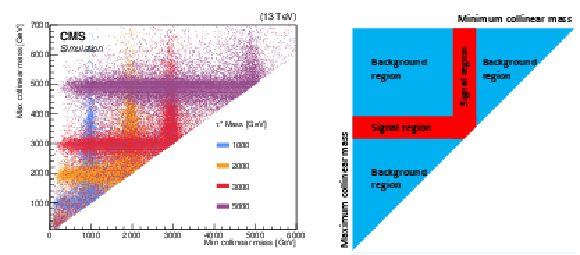
png pdf |
Figure 2:
Left, 2-dimensional collinear mass distributions for example signal mass points. Right, a diagram showing the regions contributing to the two bins in the statistical fit. |
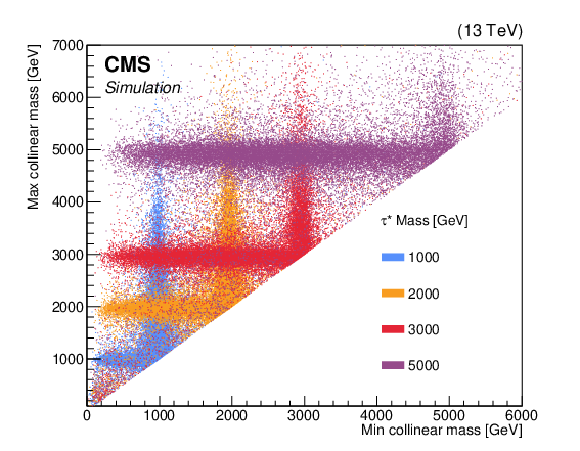
png pdf |
Figure 2-a:
Left, 2-dimensional collinear mass distributions for example signal mass points. Right, a diagram showing the regions contributing to the two bins in the statistical fit. |
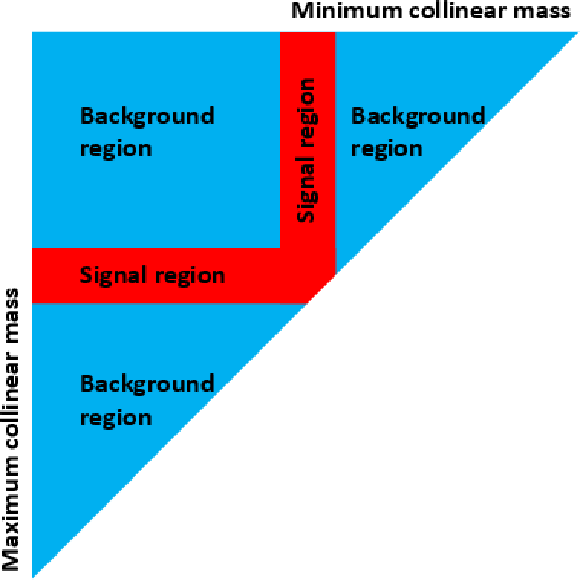
png pdf |
Figure 2-b:
Left, 2-dimensional collinear mass distributions for example signal mass points. Right, a diagram showing the regions contributing to the two bins in the statistical fit. |
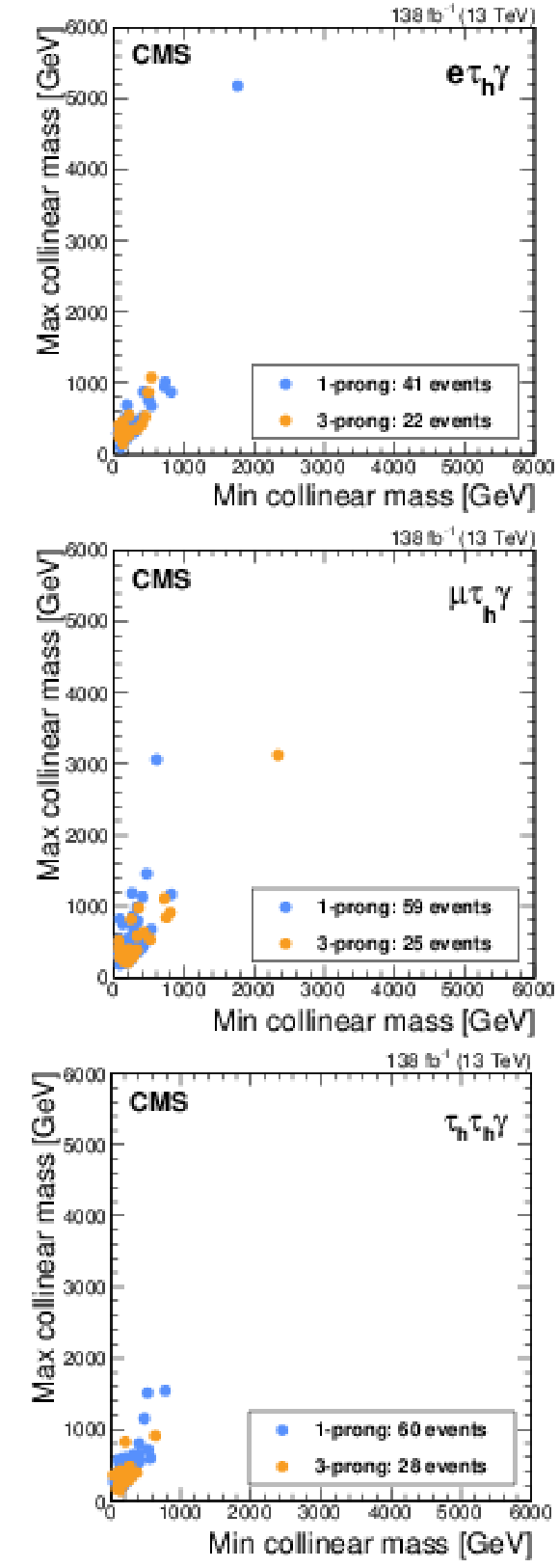
png pdf |
Figure 3:
Observed signal yields in the 2-D mass plane for the $ \mathrm{e}\tau_\mathrm{h}\gamma $ (upper), $ \mu\tau_\mathrm{h}\gamma $ (middle) and $ \tau_\mathrm{h}\tau_\mathrm{h}\gamma $ (lower) final states. |
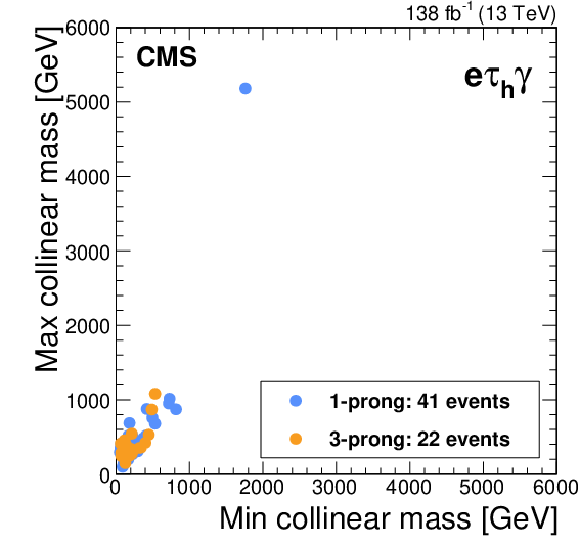
png pdf |
Figure 3-a:
Observed signal yields in the 2-D mass plane for the $ \mathrm{e}\tau_\mathrm{h}\gamma $ (upper), $ \mu\tau_\mathrm{h}\gamma $ (middle) and $ \tau_\mathrm{h}\tau_\mathrm{h}\gamma $ (lower) final states. |
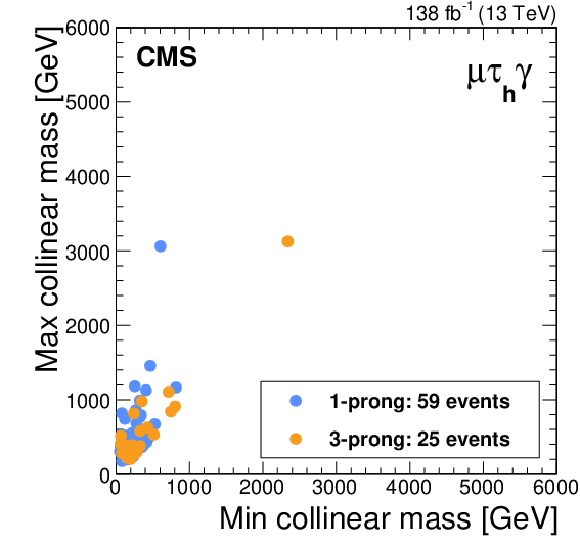
png pdf |
Figure 3-b:
Observed signal yields in the 2-D mass plane for the $ \mathrm{e}\tau_\mathrm{h}\gamma $ (upper), $ \mu\tau_\mathrm{h}\gamma $ (middle) and $ \tau_\mathrm{h}\tau_\mathrm{h}\gamma $ (lower) final states. |

png pdf |
Figure 3-c:
Observed signal yields in the 2-D mass plane for the $ \mathrm{e}\tau_\mathrm{h}\gamma $ (upper), $ \mu\tau_\mathrm{h}\gamma $ (middle) and $ \tau_\mathrm{h}\tau_\mathrm{h}\gamma $ (lower) final states. |
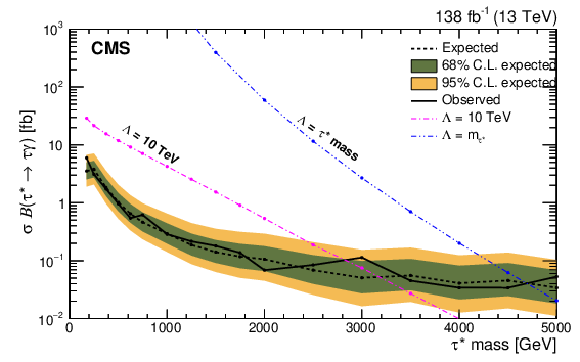
png pdf |
Figure 4:
Observed (solid-black line) and expected (dashed line) upper limits on the product of the cross section and branching fraction, as a function of the $\tau^{*}$ mass, for single $\tau^{*}$ production via a contact interaction in association with an SM $ \tau $. The inner (green) band and the outer (yellow) band indicate the regions containing 68 and 95%, respectively, of the distribution of limits expected under the background-only hypothesis. |
| Tables | |
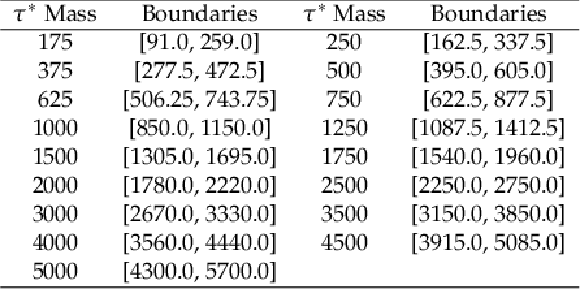
png pdf |
Table 1:
Boundaries of the signal region for each $\tau^{*}$ mass considered. All units are in GeV. |
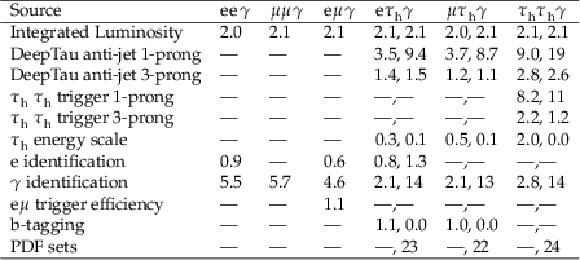
png pdf |
Table 2:
Summary of systematic uncertainties that affect the expected signal and background yields by at least 1%. Values are in % of the inclusive yield. For the columns containing no $ \tau_\mathrm{h} $ it is the size of the effect on the background. For the columns containing $ \tau_\mathrm{h} $, the first number is the value for the background and the second number is the value for the signal with $ m_{ \tau^{*}} =$ 1750 GeV and $ \Lambda = $ 10 TeV. |

png pdf |
Table 3:
Post-fit $ \kappa $ values calculated in the simultaneous background-only fit of all signal and control regions. |
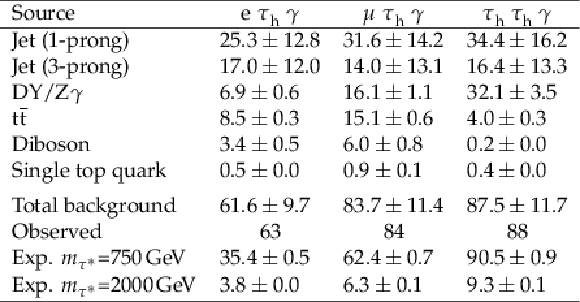
png pdf |
Table 4:
Observed events and expected background yields. The expected background yields are post-fit under the background-only hypothesis, inclusive in the collinear mass. The expected $\tau^{*}$ yields are evaluated at $ \Lambda= $ 10 TeV and the uncertainties are statistical only. |
| Summary |
| Results have been presented for a search for excited tau leptons ($\tau^{*}$) using events with two tau leptons and a photon in the final state, produced in proton-proton collisions at a center-of-mass energy of 13 TeV. It is assumed that the excited tau lepton is produced via a contact interaction in association with a ground state tau lepton. The mass of the $\tau^{*}$ is reconstructed from the missing transverse momentum, assuming the momenta of the neutrinos from the $ \tau $ decays lie along the directions of the visible $ \tau $ decay products. No excess of events is observed above the expected SM backgrounds. This null result is used to set upper limits on the cross section times branching fraction for this process. Assuming a compositeness scale $ \Lambda $ equal to the $\tau^{*}$ mass, $\tau^{*}$ masses less than 4700 GeV are excluded at 95% confidence level; for $ \Lambda= $ 10 TeV this exclusion is set at 2800 GeV. This is the first experimental result covering this production and decay process in the $\tau^{*}$ mass range above 175 GeV. |
| References | ||||
| 1 | O. W. Greenberg and C. A. Nelson | Composite models of leptons | PRD 10 (1974) 2567 | |
| 2 | J. C. Pati, A. Salam, and J. A. Strathdee | Are quarks composite? | PLB 59 (1975) 265 | |
| 3 | O. W. Greenberg and J. Sucher | A quantum structure dynamic model of quarks, leptons, weak vector bosons, and Higgs mesons | PLB 99 (1981) 339 | |
| 4 | H. Terazawa, M. Yasuè , K. Akama, and M. Hayshi | Observable effects of the possible substructure of leptons and quarks | PLB 112 (1982) 387 | |
| 5 | M. Abolin et al. | Testing the compositeness of quarks and leptons | in Elementary Particles and Future Facilities (Snowmass 1982), FERMILAB-CONF-82-113-T, 1982 link |
|
| 6 | E. Eichten, K. D. Lane, and M. E. Peskin | New tests for quark and lepton substructure | PRL 50 (1983) 811 | |
| 7 | H. Harari | Composite models for quarks and leptons | Phys. Rept. 104 (1984) 159 | |
| 8 | U. Baur, M. Spira, and P. M. Zerwas | Excited quark and lepton production at hadron colliders | PRD 42 (1990) 815 | |
| 9 | K. D. Lane, F. E. Paige, T. Skwarnicki, and W. J. Womersley | Simulations of supercollider physics | Phys. Rept. 278 (1997) 291 | hep-ph/9412280 |
| 10 | CMS Collaboration | Precision luminosity measurement in proton-proton collisions at $ \sqrt{s}= $ 13 TeV in 2015 and 2016 at CMS | EPJC 81 (2021) 800 | CMS-LUM-17-003 2104.01927 |
| 11 | CMS Collaboration | CMS luminosity measurement for the 2017 data-taking period at $ \sqrt{s}= $ 13 TeV | CMS Physics Analysis Summary, 2018 CMS-PAS-LUM-17-004 |
CMS-PAS-LUM-17-004 |
| 12 | CMS Collaboration | CMS luminosity measurement for the 2018 data-taking period at $ \sqrt{s}= $ 13 TeV | CMS Physics Analysis Summary, 2019 CMS-PAS-LUM-18-002 |
CMS-PAS-LUM-18-002 |
| 13 | CMS Collaboration | Search for excited leptons in pp collisions at $ \sqrt{s}= $ 7 TeV | PLB 720 (2013) 309 | CMS-EXO-11-034 1210.2422 |
| 14 | CMS Collaboration | Search for excited leptons in proton-proton collisions at $ \sqrt{s} = $ 8 TeV | JHEP 03 (2016) 125 | CMS-EXO-14-015 1511.01407 |
| 15 | CMS Collaboration | Search for excited leptons in $ \ell\ell\gamma $ final states in proton-proton collisions at $ \sqrt{s}= $ 13 TeV | JHEP 04 (2019) 015 | CMS-EXO-18-004 1811.03052 |
| 16 | ATLAS Collaboration | Search for excited $\tau$-leptons and leptoquarks in the final state with $\tau$-leptons and jets in pp collisions at $ \sqrt{s} = $ 13 TeV with the ATLAS detector | JHEP 06 (2023) 199 | 2303.09444 |
| 17 | ATLAS Collaboration | Search for new phenomena in events with three or more charged leptons in $ pp $ collisions at $ \sqrt{s}= $ 8 TeV with the ATLAS detector | JHEP 08 (2015) 138 | 1411.2921 |
| 18 | ALEPH Collaboration | Search for excited leptons at 130--140 GeV | PLB 385 (1996) 445 | |
| 19 | DELPHI Collaboration | Search for composite and exotic fermions at LEP 2 | EPJC 8 (1999) 41 | hep-ex/9811005 |
| 20 | OPAL Collaboration | Search for unstable heavy and excited leptons at LEP 2 | EPJC 14 (2000) 73 | hep-ex/0001056 |
| 21 | L3 Collaboration | Search for excited leptons at LEP | PLB 568 (2003) 23 | hep-ex/0306016 |
| 22 | CMS Collaboration | HEPData record for this analysis | link | |
| 23 | CMS Collaboration | Performance of the CMS Level-1 trigger in proton-proton collisions at $ \sqrt{s} = $ 13 TeV | JINST 15 (2020) P10017 | CMS-TRG-17-001 2006.10165 |
| 24 | CMS Collaboration | The CMS trigger system | JINST 12 (2017) P01020 | CMS-TRG-12-001 1609.02366 |
| 25 | CMS Collaboration | The CMS experiment at the CERN LHC | JINST 3 (2008) S08004 | |
| 26 | T. Sjöstrand et al. | An introduction to PYTHIA 8.2 | Comput. Phys. Commun. 191 (2015) 159 | 1410.3012 |
| 27 | J. Alwall et al. | The automated computation of tree-level and next-to-leading order differential cross sections, and their matching to parton shower simulations | JHEP 07 (2014) 079 | 1405.0301 |
| 28 | S. Hoeche et al. | Matching parton showers and matrix elements | in HERA and the LHC: A Workshop on the Implications of HERA for LHC Physics, CERN/DESY, 2005 DESY Workshop 200 (2005) 288 |
hep-ph/0602031 |
| 29 | R. Frederix and S. Frixione | Merging meets matching in MC@NLO | JHEP 12 (2012) 061 | 1209.6215 |
| 30 | P. Nason | A new method for combining NLO QCD with shower Monte Carlo algorithms | JHEP 11 (2004) 040 | hep-ph/0409146 |
| 31 | S. Frixione, P. Nason, and C. Oleari | Matching NLO QCD computations with parton shower simulations: the POWHEG method | JHEP 11 (2007) 070 | 0709.2092 |
| 32 | S. Alioli, P. Nason, C. Oleari, and E. Re | A general framework for implementing NLO calculations in shower monte carlo programs: the POWHEG BOX | JHEP 06 (2010) 043 | 1002.2581 |
| 33 | P. Artoisenet, R. Frederix, O. Mattelaer, and R. Rietkerk | Automatic spin-entangled decays of heavy resonances in Monte Carlo simulations | JHEP 03 (2013) 015 | 1212.3460 |
| 34 | NNPDF Collaboration | Parton distributions from high-precision collider data | EPJC 77 (2017) 663 | 1706.00428 |
| 35 | CMS Collaboration | Extraction and validation of a new set of CMS PYTHIA8 tunes from underlying-event measurements | EPJC 80 (2020) 4 | CMS-GEN-17-001 1903.12179 |
| 36 | GEANT4 Collaboration | GEANT 4---a simulation toolkit | NIM A 506 (2003) 250 | |
| 37 | CMS Collaboration | Particle-flow reconstruction and global event description with the CMS detector | JINST 12 (2017) P10003 | CMS-PRF-14-001 1706.04965 |
| 38 | CMS Collaboration | Technical proposal for the Phase-II upgrade of the Compact Muon Solenoid | CMS Technical Proposal CERN-LHCC-2015-010, CMS-TDR-15-02, 2015 CDS |
|
| 39 | CMS Collaboration | Performance of missing transverse momentum reconstruction in proton-proton collisions at $ \sqrt{s} = $ 13 TeV using the CMS detector | JINST 14 (2019) P07004 | CMS-JME-17-001 1903.06078 |
| 40 | CMS Collaboration | Identification of hadronic tau lepton decays using a deep neural network | JINST 17 (2022) P07023 | CMS-TAU-20-001 2201.08458 |
| 41 | CMS Collaboration | Electron and photon reconstruction and identification with the CMS experiment at the CERN LHC | JINST 16 (2021) P05014 | CMS-EGM-17-001 2012.06888 |
| 42 | CMS Collaboration | Identification of heavy-flavour jets with the CMS detector in pp collisions at 13 TeV | JINST 13 (2018) P05011 | CMS-BTV-16-002 1712.07158 |
| 43 | E. Bols et al. | Jet flavour classification using DeepJet | JINST 15 (2020) P12012 | 2008.10519 |
| 44 | CMS Collaboration | Performance summary of AK4 jet b tagging with data from proton-proton collisions at 13 TeV with the CMS detector | CMS Detector Performance Summary CMS-DP-2023-005, 2023 CDS |
|
| 45 | A. L. Read | Presentation of search results: The CL$ _{\text{s}} $ technique | JPG 28 (2002) 2693 | |
| 46 | T. Junk | Confidence level computation for combining searches with small statistics | NIM A 434 (1999) 435 | hep-ex/9902006 |
| 47 | G. Cowan, K. Cranmer, E. Gross, and O. Vitells | Asymptotic formulae for likelihood-based tests of new physics | EPJC 71 (2011) 1554 | 1007.1727 |
| 48 | CMS Collaboration | The CMS statistical analysis and combination tool: Combine | Submitted to Comput. Softw. Big Sci, 2024 | CMS-CAT-23-001 2404.06614 |
| 49 | R. Barlow and C. Beeston | Fitting using finite Monte Carlo samples | Computer Physics Communications 77 (1993) 219 | |
| 50 | J. S. Conway | Incorporating nuisance parameters in likelihoods for multisource spectra | in PHYSTAT, 2011 link |
1103.0354 |

|
Compact Muon Solenoid LHC, CERN |

|

|

|

|

|

|